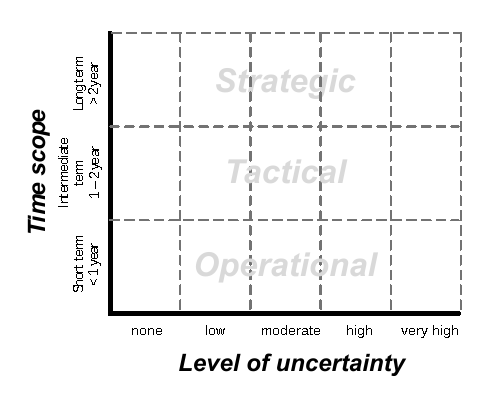Tool 19 Classification of certainty of future acts and events
By: Erik Elderman
“No one can honestly predict with certainty the future. The future is a mixture of some fairly predictable things and many things that are impossible to predict.” (Brown, 2007)
After the creation of a list with new ideas for future acts and events in tool 18, the next step in the Four Cycles method is to classify all items on this list. This classification should be performed on the likelihood that the act or event occurs; the level of (un)certainty, and when the act or event is believed to occur; the time scope. Classifying all items according to these two dimensions yields a clear overview of the acts and events in need for attention and at what point in time.
(Un)Certainty
Predicting the likelihood that events occur can be difficult. Mintzberg (1994) states that certain repetitive patterns, like season-sales, can be predicted very precisely, but predicting discontinuities, such as technological innovations, is virtually impossible. Some people “see” such discontinuities coming, but no formal method is available to predict those events – it has to do with individual arguments and intuition. To help decision makers to predict as good as possible the likelihood that an act or event occurs, information is required. Tools which can be used to obtain information are: annual reports; competition analysis’ and demand-/ trend forecasts.
To make a classification of the certainty of the future acts and events, one should use a grading tool. By giving points to indicate the level of certainty that an act or event will occur, order can be created within the generated list. A structured way of grading is using a Likert-scale, at which each scale point has his own labelled value (e.g. 5 points, from 1 = certain to 5 = high level of uncertainty). All acts and events must be scored with a level of (un)certainty.
Time scope
Placing acts and events in timeframes within the future yields valuable information due to the question: ‘what needs to be attended to next?’. A wide known and often (in goal planning) used set of timeframes is the distinction between: short-term [0-1 year; operational level], intermediate term [1-2 year; tactical level] and long-term [2 -5 years; strategic level] (Daft & Marcic, 2009). Subdividing all items within this frame gives a clear overview of when action should be taken, but also provides the decision makers an extra tool to see events in time perspective. When for example a sale loss is predicted over 2 years due to new innovative technologies, perhaps immediate measures may need to be taken to sustain in business.
Organisational
A group of stakeholders can do the grading process mentioned above. Stakeholders are for instance middle and lower-level managers and project members with ‘inside’-experience and knowledge. This group can join in a meeting with delegates of the information researchers. The participating stakeholders can all use the grading method to further specify and qualify the list of future acts and events.
References:
Brown, D. (2007) Horizon scanning and the business environment – the implications for risk management. BT Technology Journal, 25(1), pp. 209.
Daft, R.L. & Marcic, D. (2009) Understanding management. 6th edition. South-Western Centgage Learning, Mason, USA, pp. 152-161.
Mintzberg, H. (1994) The fall and rise of strategic planning. Harvard Business Review. Jan-Febr, pp. 107 – 114.

